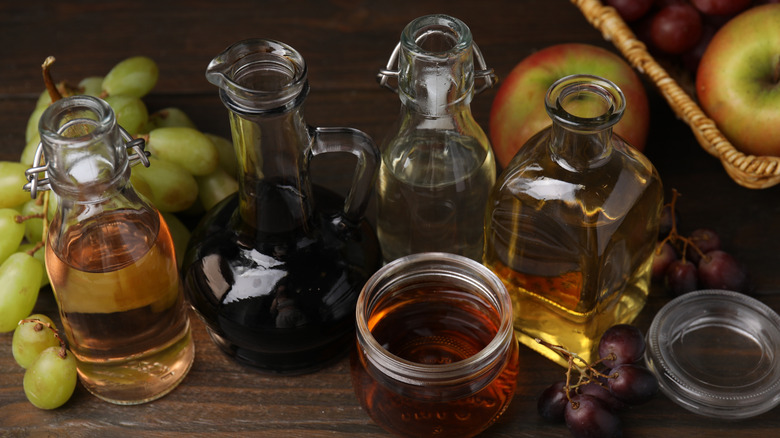How Acid Levels Play A Role In Determining How Long Vinegar Lasts
Vinegar is the oh-so-loveable cherry on top of any savory dish. But what if one day, you crack open a prized bottle and add a generous dash, only to find disaster has struck and your vinegar has spoiled? Gone is the delicious tartness; you're left with a rancid taste, discoloration, and what looks like stray specks of sediment. If this untimely death seems a little premature, chances are the vinegar's acid levels are to blame. The natural acidity of the condiment acts as protection against bacteria. However, as it oxidizes, this PH barrier reduces, leaving it vulnerable to spoilage. The lower the initial acidity level, the quicker it is prone to going bad.
Fancy a prediction for the lifespan of future bottles? Check the label. It should indicate a bottle-specific best-by-date. It's easy to get laidback when vinegar is characterized as such an ever-lasting, infinitely usable product. But you can avoid nasty spoiling surprises by keeping your eye on the clock and being savvy with which types you buy. A general rule of thumb is around two to three years, depending on adequate storage at a suitably cool (not cold) temperature. Anything above 5% acidity is the gold standard: Keeping this in mind is also one of the top tips you need when cooking with vinegar.
What types of vinegar last the longest?
Now that you know how acidity levels dictate the shelf-life of vinegar, you won't be surprised to hear that not all bottles last the same duration. Different types of vinegar last varying lengths of time, so you might want to get tactical next time you head to the supermarket. As a general rule, distilled vinegar offers the best bang for your buck, with an almost open-ended shelf life.
Some variations are actually intentionally aged, like balsamic, for instance. But does balsamic vinegar ever go bad? You bet. Most commercial balsamic has a shelf-life of up to five years. Another valuable bit of information to learn is how long apple cider vinegar lasts and what to look for when it goes bad. This fermented condiment is another of the longest-lasting vinegars, remaining suitable for consumption for up to five years when left unopened and two years when opened. It can be tricky to tell when it goes bad, though, as fermentation often creates a cloudy appearance from day one. It's better to judge by the excessiveness of cloudiness and sediment, as well as rancid developments in taste or aroma.
Smaller bottles are also optimal for avoiding spoilage, as they naturally introduce less oxygen since you use them quicker. Aside from savvy selection, remember that "go big or go home" doesn't apply in the case of vinegar longevity.

